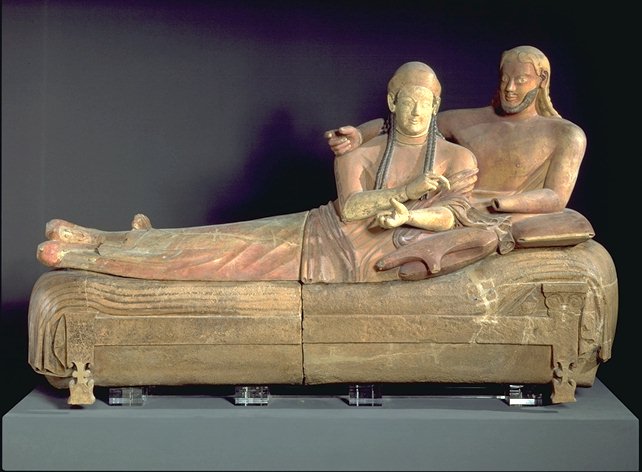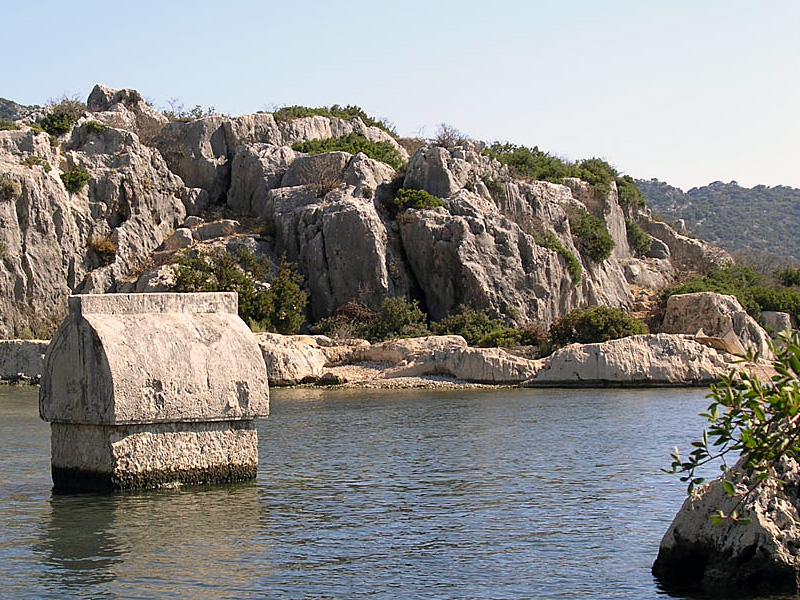On coffins, etc.
Ancient Coffin Depicts Scenes from Homer's Odyssey, Iliad
By George Psyllides
Associated Press
posted: 21 March 2006
11:07 am ET
NICOSIA, Cyprus (AP) -- A 2,500-year-old sarcophagus with vivid color illustrations from Homer's epics has been discovered in western Cyprus, archaeologists said Monday.

And there it is (click on it to see a bigger version). You can quite clearly see a chariot containing two warriors, with the man in front driving, and the fellow behind him carrying a bow. The horse appears to be trampling somebody, and there's another chariot coming up behind the one shown. There's no telling which bit of the Iliad or Odyssey it's depicting - people riding around in chariots form a big part particularly of the Iliad. Here's a sample:
Aeneas answered, "Say no more. Things will not mend till we two go
against this man with chariot and horses and bring him to a trial of
arms. Mount my chariot, and note how cleverly the horses of Tros can
speed hither and thither over the plain in pursuit or flight. If
Jove again vouchsafes glory to the son of Tydeus they will carry us
safely back to the city. Take hold, then, of the whip and reins
while I stand upon the car to fight, or else do you wait this man's
onset while I look after the horses."
"Aeneas." replied the son of Lycaon, "take the reins and drive; if
we have to fly before the son of Tydeus the horses will go better
for their own driver. If they miss the sound of your voice when they
expect it they may be frightened, and refuse to take us out of the
fight. The son of Tydeus will then kill both of us and take the
horses. Therefore drive them yourself and I will be ready for him with
my spear."
They then mounted the chariot and drove full-speed towards the son
of Tydeus. Sthenelus, son of Capaneus, saw them coming and said to
Diomed, "Diomed, son of Tydeus, man after my own heart, I see two
heroes speeding towards you, both of them men of might the one a
skilful archer, Pandarus son of Lycaon, the other, Aeneas, whose
sire is Anchises, while his mother is Venus. Mount the chariot and let
us retreat. Do not, I pray you, press so furiously forward, or you may
get killed." Iliad, Book V.
Homeric scenes are not especially rare on sarcophagi, which is not surprising considering the popularity of the works in ancient times. Here's another example (once again, click on it to see the bigger picture), showing a scene from the Odyssey.

"I had hardly finished telling everything to the men before we
reached the island of the two Sirens, for the wind had been very
favourable. Then all of a sudden it fell dead calm; there was not a
breath of wind nor a ripple upon the water, so the men furled the
sails and stowed them; then taking to their oars they whitened the
water with the foam they raised in rowing. Meanwhile I look a large
wheel of wax and cut it up small with my sword. Then I kneaded the wax
in my strong hands till it became soft, which it soon did between
the kneading and the rays of the sun-god son of Hyperion. Then I
stopped the ears of all my men, and they bound me hands and feet to
the mast as I stood upright on the crosspiece; but they went on rowing
themselves. When we had got within earshot of the land, and the ship
was going at a good rate, the Sirens saw that we were getting in shore
and began with their singing.
"'Come here,' they sang, 'renowned Ulysses, honour to the Achaean
name, and listen to our two voices. No one ever sailed past us without
staying to hear the enchanting sweetness of our song- and he who
listens will go on his way not only charmed, but wiser, for we know
all the ills that the gods laid upon the Argives and Trojans before
Troy, and can tell you everything that is going to happen over the
whole world.'
"They sang these words most musically, and as I longed to hear
them further I made by frowning to my men that they should set me
free; but they quickened their stroke, and Eurylochus and Perimedes
bound me with still stronger bonds till we had got out of hearing of
the Sirens' voices. Then my men took the wax from their ears and
unbound me. Odyssey, Book XII
Anyway, there's not too much to this week's Friday Archaeology Blogging; I really just wanted to show some nice pictures of sarcophagi (the word, incidentally, literally means "flesh-eating," and refers to the limestone commonly used in their construction, which caused the bodies within to decompose rapidly). I would point out that they are intrinsically interesting as objets d'art, in particular those made by the Etruscans. For one thing, early Etruscan sarcophagi are our only real source of information on what Etruscan houses looked like:

For another, they occasionally included detailed, life-sized, representations of the people buried within:

I will close this brief digression on sarcophagi by saying only that I would very badly like to know the story behind this one:



2 comments:
gotta say, I'm loving the archaeology Fridays
Thanks Rev.!! I do like writing them as well; it's nice to take a bit of a break from snarkiness sometimes (except, of course, for the snarky editions of Archaeology Friday).
Post a Comment